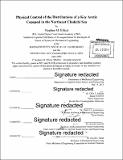Physical control of the distributions of a key Arctic copepod in the Northeast Chukchi Sea
Author(s)
Elliott, Stephen M. (Stephen Malcolm)
DownloadFull printable version (12.82Mb)
Other Contributors
Woods Hole Oceanographic Institution.
Advisor
Carin J. Ashjian.
Terms of use
Metadata
Show full item recordAbstract
The copepod Calanus glacialis is one of the most important zooplankton taxa in the Arctic shelf seas where it serves as a key grazer, predator, and food source. Its summer distribution and abundance has direct effects on much of the food web, from blooming phytoplankton to migrating bowhead whales. The Chukchi Sea represents a highly advective regime dominated by a barotropicly driven northward flow modulated by wind driven currents that reach the bottom boundary layer of this shallow environment. In addition, a general northward gradient of decreasing temperature and food concentration leads to geographically divergent copepod growth and development rates. The physics of this system establish the connection potential between specific regions. Unless biological factors are uniform and ideal the true connections will be an uneven subset of this physically derived connection potential. In August 2012 and 2013, C. glacialis distributions were observed over Hanna Shoal in the northeast Chukchi Sea. Here we used the Finite Volume Community Ocean Model i-State Configuration Model to advect these distributions forward and back in time to determine the source and sink regions of the transient Hanna Shoal C. glacialis population. We found that Hanna Shoal supplies diapause competent C. glacialis to both the Beaufort Slope and the Chukchi Cap, mainly receives juveniles from the broad slope between Hanna Shoal and Herald Canyon and receives second year adults from as far as the Anadyr Gulf and as close as the broad slope between Hanna Shoal and Herald Canyon. These connection potentials were not sensitive to precise times and locations of release, but were quite sensitive to depth of release. Deeper particles often traveled further than shallow particles due to strong vertical shear in the shallow Chukchi. The 2013 sink region was shifted west relative to the 2012 region and the 2013 adult source region was shifted north relative to the 2012 region.
Description
Thesis: S.M., Joint Program in Applied Ocean Science and Engineering (Massachusetts Institute of Technology, Department of Mechanical Engineering; and the Woods Hole Oceanographic Institution), 2015. Cataloged from PDF version of thesis. Includes bibliographical references (pages 75-81).
Date issued
2015Department
Joint Program in Applied Ocean Physics and Engineering; Woods Hole Oceanographic Institution; Massachusetts Institute of Technology. Department of Mechanical EngineeringPublisher
Massachusetts Institute of Technology
Keywords
Joint Program in Applied Ocean Science and Engineering., Mechanical Engineering., Woods Hole Oceanographic Institution.